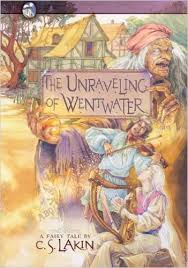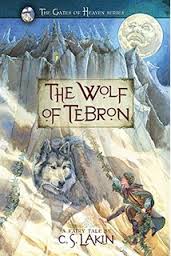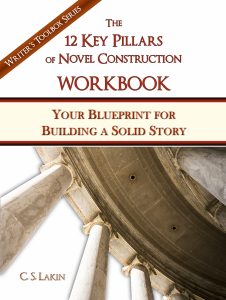How to Break Up Your Novel into Definable Sections
Last week I started diving into the three-act structure and explained that such structure is random and arbitrary. While many writing instructors swear by this structure, I feel it’s too pat and restrictive to be a “one size fits all,” and, really, it’s the story that should determine how many acts it needs. And even with that, it’s up to the writer to decide if he wants to break his story up into acts or sections.
This isn’t just about “breaking up” a story or creating actual parts to a novel. While I’m going to share more examples of this, be aware that fashioning your story into sections is extremely helpful, and it’s something you can do without labeling them as such for your readers.
Sometimes, after I’ve put all my scene ideas on index cards (as many as I can think of for my novel I’m about to write), I’ll lay them all out on my dining table. Usually I have between thirty and fifty scene ideas before I start writing my general outline.
But here’s the thing.
Once I have all these cards in front of me, I’ll start laying them out in vertical columns. When I get to the place (the bottom of a column) where it feels I’ve built up to a key plot development that presents “a door of no return” for my protagonist, I’ll start a new column with the next scene card. That next first scene starts off a new “act.”
It’s only after I do this that I learn how many “acts” I have. Does this sound weird? It may, but it works great for me.
Maybe it takes experience to know what these big “doors” are and where they should come in a story. And of course, as you get closer to the climax, there are going to be all kinds of complications.
So how do you determine what kind of complication creates such a door, where an act “officially” ends?
There are lots of methods to this as well, and as I said last week, there are plenty of books and blog posts that can give you ideas. I find James Scott Bell’s Plot and Structure a great book to start with, which focuses on the traditional three-act structure. And for the most part I feel it’s good for beginning novelists to start there. But just don’t get locked into three acts because you’ve heard you have to. You don’t.
Get Creative with Your Section Breaks
I love using section breaks to showcase some creativity. As you saw in A Thin Film of Lies, I used bits about photography, which is my main motif for the book and key to the plot.
In The Map across Time, I use one Hebrew phrase (Hebrew is my forgotten ancient language in my series, but it’s called the law’az) and the definition of the phrase as the section break marker.
In Intended for Harm I have numerous sections, all the names of Bible books and their definitions: Exodus, Numbers, Judges, Song of Songs, etc. That’s because my epic contemporary family saga is a modern-day telling of the Bible story of Jacob (and you can get the ebook HERE for free!).
In The Hidden Kingdom I created five section breaks, and in each one they tell a continuing second story line in brief fashion, as the mother (who is one of the characters in the main plot) tells a bedtime story to her son. The bedtime story being told is the novel’s story, but it’s shared in dialogue and internal thoughts, with the character reflecting on the events as they play out in the novel. In other words, I use the section breaks to insert a story within a story.
Note that these are not random choices. They are very specific and key to the plots of my novels.
I love the way Orson Scott Card does this very thing but usually with chapter breaks. In Pathfinder, my favorite of all his books (that I’ve read so far), he has a whole story unfolding about the spaceship that left Earth to populate a world far away, told in partial scenes at the start of each chapter, while the reader follows the story of what is taking place on that newly colonized world. Both story lines are essential and pull together like threads in a fabric, and in a sense they collide in a big crash at the end as all the mysteries that have been set up are exposed and clarified.
Ender’s Game also has a bit of this going on with italicized discussions prefacing the chapters. I think every novel of his that I’ve read has something like this. Dune by Frank Herbert is another great book that does this.
A Look at More Section Breaks
Let’s take a look at another of my novels (I’m using mine because I know how and why I did these section breaks. But if you know of some novels that use them, please share in the comments!). I’m pretty sure all seven of my fantasy novels in my Gates of Heaven series use section breaks.
 In The Unraveling of Wentwater, after my prologue (which features a minor character in the past experiencing the inciting incident—the baby-naming ceremony that goes awry), we have Part One. In this novel, I put “excerpts” from the scholar Antius’s treatise “The Unraveling of Wentwater.” He’s a historian and key character in this novel, and these excerpts reflect on the events taking place in the actual story, kind of as an aside.
In The Unraveling of Wentwater, after my prologue (which features a minor character in the past experiencing the inciting incident—the baby-naming ceremony that goes awry), we have Part One. In this novel, I put “excerpts” from the scholar Antius’s treatise “The Unraveling of Wentwater.” He’s a historian and key character in this novel, and these excerpts reflect on the events taking place in the actual story, kind of as an aside.
So Part One kicks off the novel. Part Two comes in at about one-third in, at the point where the antagonist of the story sets off to destroy his brother, who has won the heart of the girl he’s obsessed with. That first section’s ending feels like a huge door of no return, for Justyn is now motivated by anger and rejection and is about to set disastrous things in motion.
Part Two ends with the huge disaster of the spell gone wrong, and the world at large vanishes from existence. Only Teralyn, my heroine, remains, trapped in a magical castle. Another big door, literally, just slammed, locking her in and erasing the outer world. This comes roughly at the two-thirds mark in the novel.
And then the book ends with an Afterword, which contains the last bits of wisdom from Antius, wrapping up the show. I’m influenced by how Shakespeare does this kind of wrap-up at the end of Hamlet and other plays.
Basically, I used a three-act structure, but I didn’t sweat over where exactly these acts fell. I could have added a Part Four section break when Teralyn stitched the world back after seven years and Wentwater finally reappeared. But I just kept that whole last section together. In hindsight, I think inserting that Part Four would have made for better structure, giving more impact to the moment when she sees a piece of roof line peeking out of the snowy field.
 Here are the section breaks for The Wolf of Tebron, the first book in my fantasy series. All I have on these section break pages are the section titles:
Here are the section breaks for The Wolf of Tebron, the first book in my fantasy series. All I have on these section break pages are the section titles:
Part One: The Lunatic Moon (comes after the prologue that sets up the situation in decades past). This part covers the setup and the inciting incident, which pushes Joran to seek his missing wife and start his adventure, then ends when he gets to stop #1—the house of the Moon.
Part Two: The Angry Sun (about two-fifths in). Joran then travels east to the ends of the world till he gets to the house of the sun, stop #2, continuing his search for his wife and collecting new clues.
Part Three: The Revealing Wind (about one-half into the book). Now Joran travels to the cave of the South Wind (stop #3), where he learns shocking truths about his family and past and loses all hope (leading to his great despair before the push to the climax).
Part Four: The Unimaginable Sea (about four-fifths in) has Joran rescued from captivity, and he’s now ready to face his greatest test and fears to snatch his wife from the clutches of the Moon. It’s a brief section, which covers the climax and a bit of the resolution.
Part Five: The Shortest Way Home is placed about fifteen pages before the end and is the wrap-up and denouement for the book. It’s the final scene.
Joran had five ultimate destinations in his journey. He had to go to the four ends of the world to find his wife, save her, then return home. It seemed logical to organize this novel into these five acts or five sections. I didn’t ever consider what page each section would start on or how far into the book they’d be positioned. My “acts” were determined not by the need for commercial breaks but based on the best way I could tell this story.
Some of these acts are a hundred pages long; the last ones are often one scene, maybe fifteen pages long. So I’m also not turning this into a math equation with equal parts. If anything we’re looking a X=whatever works best. To solve for X, look to the premise of your story.
Granted, as I said last week, for me this may be a bit intuitive because I’ve written so many novels. Although, The Wolf of Tebron was only my fourth novel. I feel it’s more due to the fact I’ve read thousands of novels, and I believe we instinctively have a feel for story structure.
However, seeing how most beginning novels really lack great structure, it behooves writers to learn all they can about it. That doesn’t mean following arbitrary rules that are “one size fits all.” But there are some basic rules about structure that are time-tested and proven solid.
 And that’s why I wrote The 12 Key Pillars of Novel Construction and created the workbook with hundreds of brainstorming questions. Writers must have structure or a story won’t work. But there are creative ways to work within such structure, and using section breaks, or breaking up a story into section “chunks,” is a great way to help fashion a strong story.
And that’s why I wrote The 12 Key Pillars of Novel Construction and created the workbook with hundreds of brainstorming questions. Writers must have structure or a story won’t work. But there are creative ways to work within such structure, and using section breaks, or breaking up a story into section “chunks,” is a great way to help fashion a strong story.
Next week I’ll get a bit more into these various sections that make up story structure. But for now, share some of your thoughts. Can you break up your novel into sections? How many acts do you end up with? Have you tried putting all your scenes on index cards and laying them out to see what acts seem to appear?
If you need help with your story structure, hire me to help. This is what I do full-time. I work with hundreds of writers each year, critiquing outlines and chapters of hundreds of manuscripts. I can show you how to see your story this way, how to define and delineate those acts or sections, and point out what’s missing or not working.
Using my scene template can really help you start figuring this all out. Or we can set up a phone or Skype consultation to go over your story ideas and hammer things out. Don’t stumble around in confusion. That’s not necessary to producing a stellar novel!











This article stirred up so many possibilities in my mind for the two novels I am currently working on. I particularly like the idea of telling a related, contrasting story at the section breaks. I think this could be a great way to build thematic tension as the two apparently unrelated story lines grow inexorably closer together.
But I think that breaking the plot into separate sections, at significant plot points, can also be a good exercise while the writing is still in progress, to keep the overall structure in mind as one drafts. This could be a good way to avoid the problem of a “mushy middle,” to see where the story might be sagging and where a new plot point needs to be built in to maintain the tensile strength of the overall story arc.
Very thought provoking! Thanks for this.
Great post, thanks for sharing your writing process. You make a good point about 3 act structure being a little pat for the many variable forms the novel can take.
Bridget
Excellent advice and examples – most helpful!